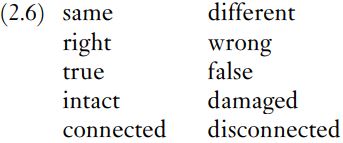


 Grammar
Grammar
 Tenses
Tenses
 Present
Present
 Past
Past
 Future
Future
 Parts Of Speech
Parts Of Speech
 Nouns
Nouns
 Verbs
Verbs
 Adverbs
Adverbs
 Adjectives
Adjectives
 Pronouns
Pronouns
 Pre Position
Pre Position
 Preposition by function
Preposition by function 
 Preposition by construction
Preposition by construction
 Conjunctions
Conjunctions
 Interjections
Interjections
 Grammar Rules
Grammar Rules
 Linguistics
Linguistics
 Semantics
Semantics
 Pragmatics
Pragmatics
 Reading Comprehension
Reading Comprehension|
Read More
Date: 2023-03-30
Date: 2023-04-20
Date: 2023-03-06
|
Complementaries
Figure 2.1 is meant to depict the fact that, at any given point in time, the whole domain of whatever is capable of moving or being stationary is divided without remainder between two non-overlapping sets (which might or might not be equally big): the moving things and those that are stationary. In the world as it is ordinarily experienced and talked about in English, moving versus stationary is a stark opposition. (I am ignoring possibilities in physics and science fiction of multiple reference points and relativity.)

Some other adjective contrasts that also divide their relevant domains sharply and without residue are listed in (2.6).

These are pairs of complementary terms. (Note the spelling. The second vowel is an e. This has nothing to do with free tickets!) Complementaries are defined in terms of a pattern of entailment illustrated in (2.7c).

It may be a bit tedious, but let me spell out how all four of the entailments in (2.7c) follow logically, assuming that the people and possessions are unchanged between explicatures of the two sentences (2.7a, b). When (2.7a) is true, which is to say when Maude’s is the same as yours, then it must be true that Maude’s is not different from yours (represented in (2.7c) as ‘NOT2.7b’). When Maude’s is not the same as yours (NOT2.7a), then (2.7b) must be true: Maude’s is different from yours. When Maude’s is different from yours (2.7b), then Maude’s is not the same as yours (NOT2.7a); and when Maude’s is not different from yours (NOT2.7b), then Maude’s is the same as yours (2.7a).
In comparison with what happens in synonymy, notice that (2.7c) provides evidence for two paraphrase pairs (sentences with the same meaning, or – another way of stating it – sentences that express the same proposition). If the two-way pair of entailments (2.7a ⇒ NOT2.7b) and (NOT2.7b ⇒ 2.7a) holds, then (2.7a) is a paraphrase of (NOT2.7b), which is to say that Maude’s is the same as yours paraphrases Maude’s is not different from yours. And if there is the mutual entailment summarized in (NOT2.7a ⇒ 2.7b) & (2.7b ⇒ NOT2.7a), then Maude’s is not the same as yours is a paraphrase of Maude’s is different from yours. Thus, complementaries can be viewed as negative synonyms.
In the discussion of synonyms, in Section 2.2.1, the sentence frame that the adjectives were put into was kept constant: Andy is ________, but for complementaries the example frame changed slightly between (2.7a) Maude’s is the ________ as yours and (2.7b) Maude’s is ________ from yours. These are differences brought about by details of English grammar. They do not have semantic significance in the present discussion. You would probably understand a non-proficient learner of English who made errors such as “Maude’s is same from yours”. My explanation of complementaries could, alternatively, have been made in terms of expressions bigger than a single word, the same as and different from, which could then have been seen as fitting into an unchanged frame in (2.7a,b).
With complementaries we get entailments from affirmative sentences (the ones lacking NOT in (2.7c)) to negative sentences (the ones with NOT in 2.7c) and back again from negative to affirmative. It will be seen in the next section that the kind of opposite that I am calling antonyms exhibit a pattern with parallels to only two of the four entailments shown in (2.7c).
|
|
|
|
دراسة يابانية لتقليل مخاطر أمراض المواليد منخفضي الوزن
|
|
|
|
|
|
|
اكتشاف أكبر مرجان في العالم قبالة سواحل جزر سليمان
|
|
|
|
|
|
|
اتحاد كليات الطب الملكية البريطانية يشيد بالمستوى العلمي لطلبة جامعة العميد وبيئتها التعليمية
|
|
|